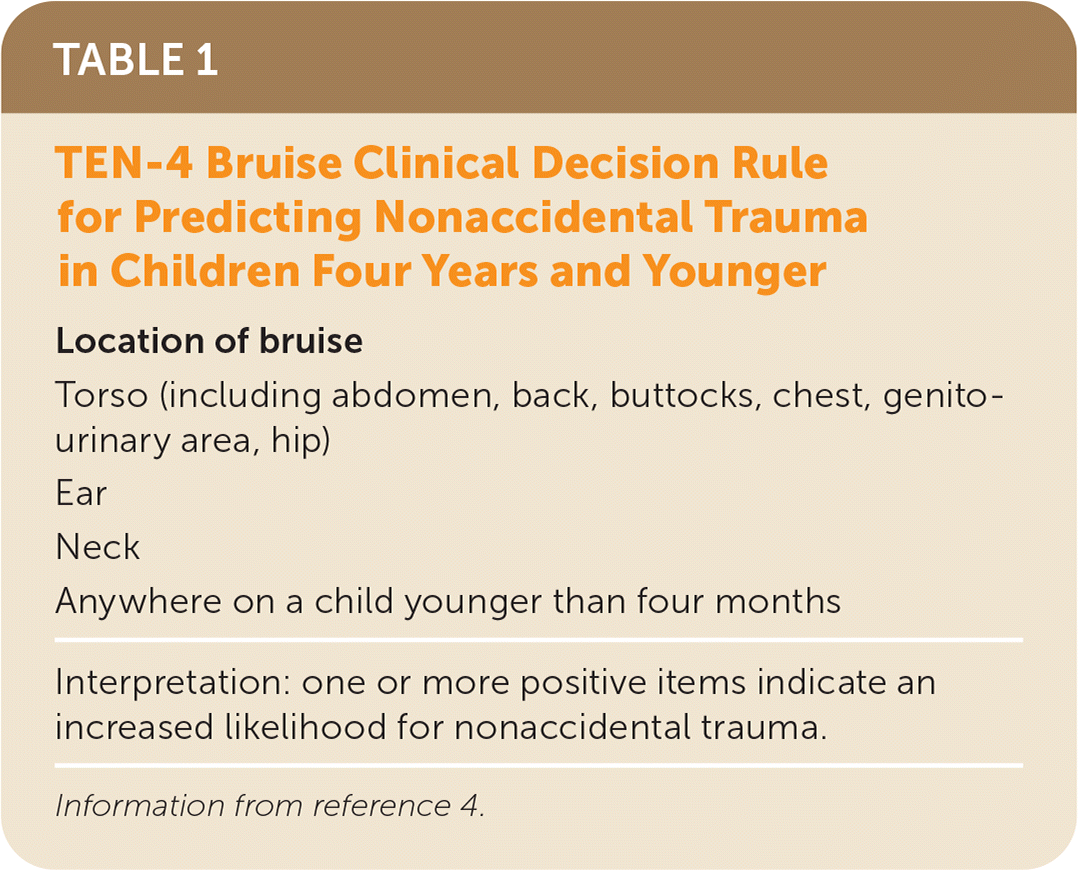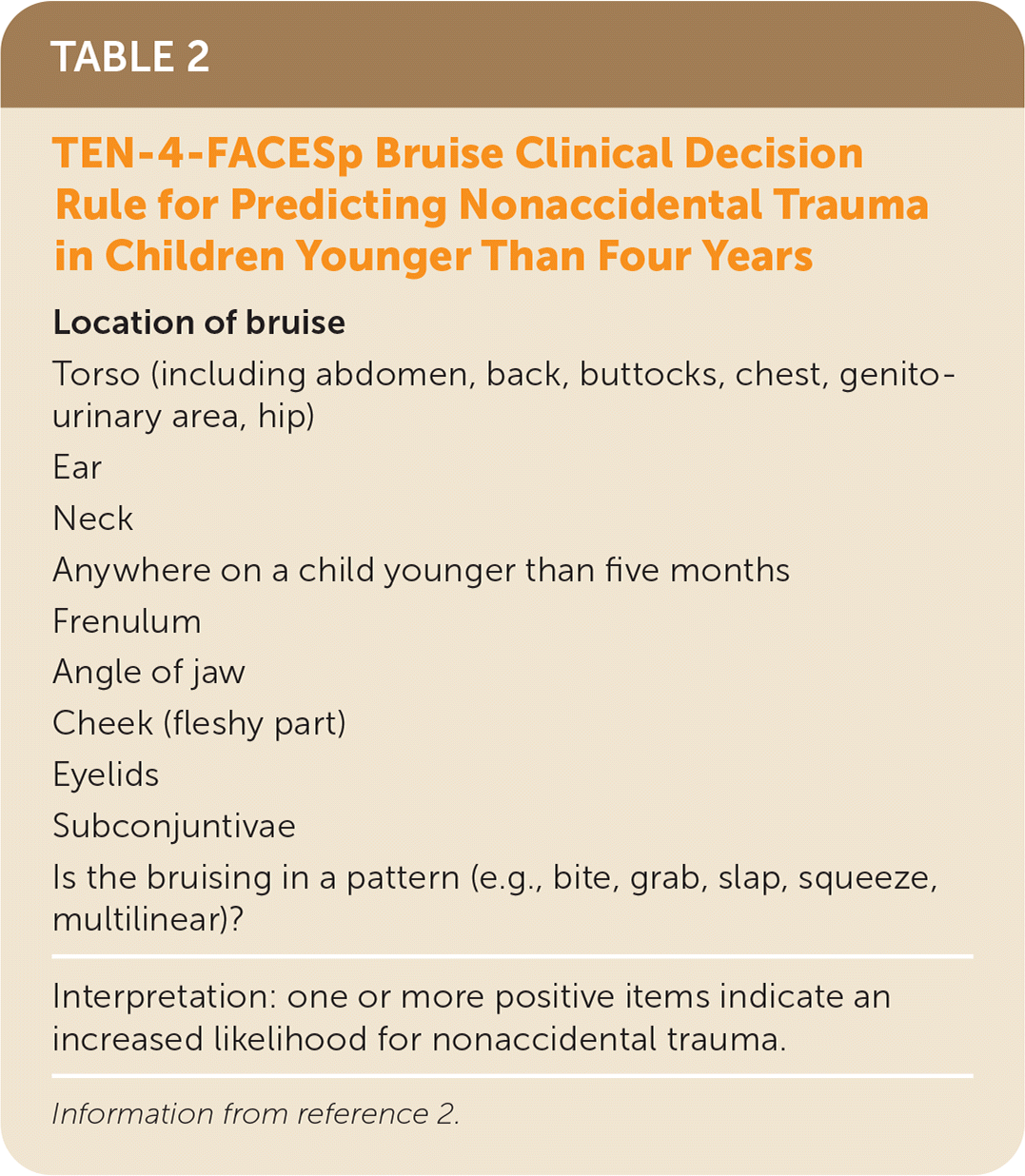
Am Fam Physician. 2022;105(6):661-662
Author disclosure: No relevant financial relationships.
Clinical Question
Evidence Summary
Among children four years and younger, 11,149 died from child abuse between 1999 and 2014.1 That is a rate of 3.5 deaths per 100,000 children in this age group per year.1 Bruising is the most common injury of child abuse to be overlooked or misdiagnosed before the death of a child due to abuse, representing a missed opportunity to intervene.2 Although some bruising is expected in newly mobile children, especially below the knees and on the forehead, accidental bruising over other areas (e.g., ears, neck, genitalia) is rare.3 A clinical prediction rule that assists physicians in discriminating nonaccidental from accidental bruising could potentially prevent the morbidity and mortality associated with a missed diagnosis of child abuse.

| Location of bruise |
| Torso (including abdomen, back, buttocks, chest, genitourinary area, hip) |
| Ear |
| Neck |
| Anywhere on a child younger than four months |
| Interpretation: one or more positive items indicate an increased likelihood for nonaccidental trauma. |
In 2021, an expanded group of researchers affiliated with five urban children's hospitals released the results of a study externally validating and refining the TEN-4 rule. In this study conducted in pediatric emergency departments in Chicago, Cincinnati, Louisville, and San Diego, researchers screened 21,123 children younger than four years for bruising from 2011 to 2016 and enrolled 2,161 children.2 Patients were excluded if they had been injured in a motor vehicle crash, had known coagulation abnormalities, spasticity from preexisting neuromuscular impairment, or extensive skin disorders because this may obscure bruise characteristics.2 The group conducted comprehensive histories and skin examinations, documented bruises with photographs and skin maps, noted bruise counts and locations, and made annotations of patient skin tone (i.e., fair, light, midtone, brown, or dark).2 Patient cases were determined as being abuse (n = 410), nonabuse (n = 1,713), or indeterminant (n = 38) by a panel of physicians and a biomechanical engineer, each with expertise in pediatric injury evaluation. Interrater reliability was high.2
Using this cohort and the original TEN-4 rule criteria, the researchers identified 331 of 410 patients who had been abused with a sensitivity of 81% (95% CI, 77% to 84%) and specificity of 91% (95% CI, 90% to 92%).4 This was considered unacceptably low by the authors, so they used this cohort to find additional predictive variables to increase sensitivity. The authors found that extending the age considered suspicious for bruising (i.e., from younger than four months to younger than five months), adding new bruising locations (i.e., frenulum, angle of the jaw, fleshy part of the cheek, eyelids, and subconjunctival bruises), and determining whether the bruising was patterned (i.e., a bite, grip, slap, squeeze, or made by a linear object; Table 22) increased sensitivity to 96% (95% CI, 93% to 97%), but decreased specificity to 87% (95% CI, 85% to 89%).2 The negative predictive value was determined to be 99% (95% Cl, 98% to 99%), the positive predictive value was 64% (95% Cl, 60% to 68%), the positive likelihood ratio was 7.4 (95% CI, 6.6 to 8.2), and the negative likelihood ratio was 0.05 (95% CI, 0.04 to 0.06). The prevalence of abuse in the sample population was 19%.2

| Location of bruise |
| Torso (including abdomen, back, buttocks, chest, genitourinary area, hip) |
| Ear |
| Neck |
| Anywhere on a child younger than five months |
| Frenulum |
| Angle of jaw |
| Cheek (fleshy part) |
| Eyelids |
| Subconjuntivae |
| Is the bruising in a pattern (e.g., bite, grab, slap, squeeze, multilinear)? |
| Interpretation: one or more positive items indicate an increased likelihood for nonaccidental trauma. |
Applying the Evidence
A 10-month-old infant is brought to the emergency department. The caregiver reports concern for intermittent vomiting and fussiness. As you examine the infant and perform a head-to-toe skin evaluation, you note bruising on the ear and back. The bruise on the back consists of two linear marks. When asked about the marks, the caregiver replies that the infant is clumsy. Applying the TEN-4-FACESp rule identifies three positive items, indicating the possibility of child abuse. You ensure the safety of the infant while the appropriate authorities are contacted.
Editor's Note: Dr. Saguil is a contributing editor for AFP.
The views expressed are those of the authors and do not reflect the official policy or position of the Uniformed Services University of the Health Sciences, the Department of the Army, the Department of Defense, or the U.S. government.
